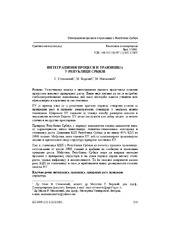Приказ основних података о документу
Integrational processes and transition in Republic of Serbia
Integracioni procesi i tranzicija u Republici Srbiji
| dc.creator | Stevanović, Simo | |
| dc.creator | Djorović, Milutin T. | |
| dc.creator | Milanović, Milan R. | |
| dc.date.accessioned | 2020-12-17T19:12:22Z | |
| dc.date.available | 2020-12-17T19:12:22Z | |
| dc.date.issued | 2008 | |
| dc.identifier.issn | 0352-3462 | |
| dc.identifier.uri | http://aspace.agrif.bg.ac.rs/handle/123456789/1687 | |
| dc.description.abstract | Main precondition for a country to achieve economic growth is to be included in integration processes. It is no longer question is it or is it not necessary to have global/regional connections, but how to make existing relations more efficient, fair and useful for all participants. EU is an example how, in relatively short period, good environment for economic growth and increase of democratic standards in new country members can be created. Outspreading of EU tension between developed West and undeveloped East Europe are diminished. EU gives good example for others in different areas. Serbian economy during 1990's was characterized by low investment, technical technological lag and stagnation of growth. Today's GDP of Republic of Serbia is 65% of GDP from 1990. However, new EU members have already compensation transitional falls and readjust their structure of economy to EU demands. Decreasing and stagnation of GDP in Republic of Serbia on the beginning of transitional process were stopped after 2000 and returned to stable and dynamic trends of growth. However, Republic of Serbia needs to perform significant changes in economic structure and to maintain on long term high growth rate, reduce inflation and unemployment. That will contribute to further growth of GDP per capita and bring Serbia closer to level of development of other EU countries. | en |
| dc.description.abstract | Uključivanje zemalja u integracione procese predstavlja osnovni preduslov njihovog privrednog rasta. Više nije pitanje da li je potrebno globalno/regionalno povezivanje, već kako postojeće odnose učiniti što efikasnijim i korisnim za sve učesnike. EU je primer kako su u relativno kratkom periodu stvoreni uslovi za privredni rast i primenu demokratskih standarda u zemljama novim članicama. Širenjem EU smanjene su tenzije između razvijene zapadne i nerazvijene istočne Evrope. EU može poslužiti kao dobar model za nešto slično i na drugim prostorima. Privredu Republike Srbije, u periodu devedesetih godina dvadesetog veka, su karakterisale niske investicije, tehničko-tehnološko zaostajanje i stagnacija rasta. Današnji BDP Republike Srbije je na nivou 65% BDP iz 1990. godine. Međutim, nove članice EU, već su kompenzirale tranzicijske padove i prilagodile svoju strukturu privrede zahtevima EU. Pad i stagnacija BDP u Republici Srbiji na početku procesa tranzicije, zaustavljeni su posle 2000. godine i vraćeni na stabilne i pozitivne trendove rasta. Međutim, Republika Srbija mora da izvrši značajne promene u privrednoj strukturi i na duži period održi visoku stopu rasta, smanji inflaciju i nezaposlenost. To će svakako doprineti daljem rasu BDP po stanovniku i tako je približiti nivou razvijenosti ostalih zemalja EU. | sr |
| dc.publisher | Naučno društvo agrarnih ekonomista Balkana, Beograd, Institut za ekonomiku poljoprivrede, Beograd i Akademija ekonomskih nauka, Bukurešt | |
| dc.rights | openAccess | |
| dc.rights.uri | https://creativecommons.org/licenses/by-sa/4.0/ | |
| dc.source | Ekonomika poljoprivrede | |
| dc.subject | integrations | en |
| dc.subject | transition | en |
| dc.subject | economic growth | en |
| dc.subject | economic structure | en |
| dc.subject | integracije | sr |
| dc.subject | tranzicija | sr |
| dc.subject | privredni rast | sr |
| dc.subject | privredna struktura | sr |
| dc.title | Integrational processes and transition in Republic of Serbia | en |
| dc.title | Integracioni procesi i tranzicija u Republici Srbiji | sr |
| dc.type | article | |
| dc.rights.license | BY-SA | |
| dc.citation.epage | 265 | |
| dc.citation.issue | 3 | |
| dc.citation.other | 55(3): 253-265 | |
| dc.citation.spage | 253 | |
| dc.citation.volume | 55 | |
| dc.identifier.fulltext | http://aspace.agrif.bg.ac.rs/bitstream/id/576/1684.pdf | |
| dc.identifier.rcub | https://hdl.handle.net/21.15107/rcub_agrospace_1687 | |
| dc.type.version | publishedVersion |


